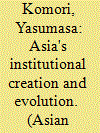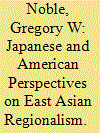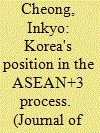| Srl | Item |
| 1 |
ID:
092002


|
|
|
|
|
| Publication |
2009.
|
| Summary/Abstract |
This article explores the formation and evolution of regional institutionas in the Asia-Pacific and East Asia. Employing a historical institutionalist framework, this article institutions were created at critical junctures, precipitated by extra-region-al developments that called the legitimacy of existing institutional mechanisms into serious question. Preexisting institutions greatly shaped the institutional design of the subsequesnt regional isntitutions, revealing a path-dependent nature of institutional evolution.The timing and sequence of regional institution building is an important factor for explaining institutional change.
|
|
|
|
|
|
|
|
|
|
|
|
|
|
|
|
| 2 |
ID:
072706


|
|
|
|
|
| Publication |
2005.
|
| Summary/Abstract |
An East Asian Summit will be held in Malaysia this December. Like other institutions in the region, the summit will be hosted by ASEAN. Only nations that have signed the Treaty of Amity and Cooperation in Southeast Asia (or TAC), which sets out the basic principles of ASEAN, will receive an invitation to the summit from ASEAN. This unprecedented summit may become a historic starting point on the path towards the founding of an East Asian community. If so, the TAC may well come to represent the basic principles of the East Asian community. The commitment to peaceful resolution of conflict that is enshrined in the TAC could be expanded from Southeast Asia to East Asia. If a Treaty of Amity and Cooperation in East Asia could be concluded, it would surely constitute a major contribution to peace and prosperity in East Asia. At the same time, however, it is likely that the bedrock principle of non-interference in the internal affairs of other countries-as stipulated in the TAC-would also become a fundamental doctrine of an East Asian community. Even within ASEAN there are some who regard this principle as outdated, as it is used as a pretext for resisting pressure to democratize. If it retains the TAC as its basis, will an East Asian community be able to share the concept of democracy?
|
|
|
|
|
|
|
|
|
|
|
|
|
|
|
|
| 3 |
ID:
061968


|
|
|
| 4 |
ID:
067597


|
|
|
| 5 |
ID:
081499


|
|
|
|
|
| Publication |
2008.
|
| Summary/Abstract |
Regular convening of East Asian summits and rising concerns about the American dollar have heightened interest in Asian cooperation. Japan will necessarily play a central role in regional endeavors, and the United States must at least acquiesce if regional coordination is to progress. Among American accounts, the most theoretically elaborate and systematically comparative analysis is A World of Regions, while Remapping East Asia provides the most authoritative overview of recent developments. Japanese-language studies of East Asian regionalism agree that regional cooperation is far less institutionalized and rule-based in East Asia than in Europe, but they include a wider range of opinion about the desirability and feasibility of cooperation. Skeptics on the right warn that efforts to create a regional community would weaken the United States-Japan alliance, undermine universal values, and cede regional leadership to China. Optimists on the left counter that regional cooperation holds out the only hope for ameliorating nationalist conflicts. Most numerous are centrists arguing for active cooperation on economics and the environment, but only cautious moves on politics and security. Despite their caution, Japanese authors convey a sense that changes to the American-led global and regional order are occurring and likely will continue.
|
|
|
|
|
|
|
|
|
|
|
|
|
|
|
|
| 6 |
ID:
074971


|
|
|
|
|
| Publication |
2006.
|
| Summary/Abstract |
The East Asian Summit was an epochal event, galvanizing the region and offering the hope of greater political, economic and social cooperation. However, the veneer of diplomatic nicety is undermined by the divergence of opinion regarding the form and functionality of the proposed East Asian Community (EAC). This article examines the Japanese and Malaysian conceptions of EAC, arguing that there are notable differences in the perspectives of the two nations. Of particular interest is the issue of Japan's involvement in the determination of the EAC process. This article will examine Japan's level of commitment to EAC and whether it desires to take on a leadership role or prefers to take a sideline approach to community-building.
|
|
|
|
|
|
|
|
|
|
|
|
|
|
|
|
| 7 |
ID:
085916


|
|
|
|
|
| Publication |
2008.
|
| Summary/Abstract |
For sveral years after the financial crisis, Korea was Quite an active participant in the ASEAN+3 process, leading the discussion on East Asian economic cooperation through the proposals for the establishment of the East Asian Vision Group (EAVG) and the East Asian Study Group(EASG).
|
|
|
|
|
|
|
|
|
|
|
|
|
|
|
|
| 8 |
ID:
074736


|
|
|
|
|
| Publication |
2006.
|
| Summary/Abstract |
Russia has been struggling to develop a relationship with the Association of Southeast Asian Nations (ASEAN) and to be included in Asia-Pacific regionalism. The rebirth of Russia after the demise of the Soviet Union in December 1991 brought with it a repudiation of superpower ambitions and outlying areas such as Southeast Asia dropped in terms of priorities. It was only after Putin emerged as president in April 2000 that Russias interest in Southeast Asia rekindled, and there were two reasons for this. The first was the recognition of the importance of Asia-Pacific regionalism for Russias development and that the economic development of Siberia and the Russian Far East required closer integration with Asian regional institutions. Under Putin, Russia moved to forge closer ties with ASEAN and to stake a claim in an emerging East Asian regionalism, a claim that was supported by Malaysia. Moreover, Putin became Russias major arms salesman and sought to expand arms sales with ASEAN actors: Vietnam, Malaysia, Indonesia, and Thailand. When the East Asian Summit (EAS) was held in Kuala Lumpur in December 2005 Russia was poised to assume a new role in Southeast Asia.
|
|
|
|
|
|
|
|
|
|
|
|
|
|
|
|
| 9 |
ID:
083833


|
|
|
|
|
| Publication |
2008.
|
| Summary/Abstract |
The East Asia Summit is the newest leaders-led regional organization in the Asia Pacific with a broad mandate and an unclear future. Its membership means that it is stuck halfway between being an East Asian regional body such as the ASEAN+3 process and an Asia-Pacific body such as Asia-Pacific Economic Cooperation. Expanding the East Asia Summit to include the United States would enhance its ability to be the primary strategic forum in Asia and clearly identify the Summit as an Asia-Pacific body. This would not only improve Asia's regional architecture, but would also serve the interests of the United States, ASEAN, Japan, China and India. The biggest challenge facing this positive development is convincing the United States to sign the Treaty of Amity and Cooperation and overcoming the concerns of the other regional bodies about an enhanced East Asia Summit. In 2009, a new administration in Washington and the EAS meeting in Vietnam will provide a powerfully symbolic opportunity to invite the United States into the East Asia Summit and allow the Summit and the United States to find their proper homes in Asia's evolving regionalism.
|
|
|
|
|
|
|
|
|
|
|
|
|
|
|
|